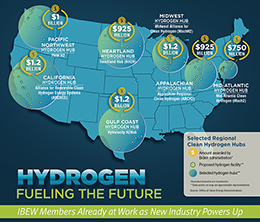
HYDROGEN:
FUELING THE FUTURE
Hydrogen, the fuel that can burn in turbines and emit only water vapor, was given a $7 billion push from fantasy to reality, and IBEW members are already at work.
The federal government awarded seven regional hydrogen hubs about $1 billion each, grants that will spur more than $40 billion in private and state funding, according to the White House.
"The clean energy transition is not pie in the sky. It is happening right now, and it is being built the right way, with union trades workers getting the lion's share of the work," said International President Kenneth W. Cooper.
Hydrogen is transformational because it can take much of the role of natural gas in the energy ecosystem. It can be distributed by pipelines and burned when needed, but nothing but water vapor comes out of the "smoke" stacks. It also can work in tandem with massive nuclear plants, using excess power during periods of low demand.
For the IBEW, old hands and new members alike, it means tens of thousands of jobs and millions of hours of work, including at former fossil fuel powerhouses.
The hydrogen hub grants were funded by the Bipartisan Infrastructure Law signed by President Joe Biden in 2022, the largest U.S. infrastructure bill ever with the strongest prevailing wage and labor standards of any law to come out of Washington.
The seven projects are in California, the Mid-Atlantic, Appalachia, the Midwest, the Gulf Coast, the northern Plains and the Pacific Northwest. Together, they will eliminate 25 million metric tons of carbon dioxide emissions from end uses each year — an amount roughly equivalent to the emissions of 5.5 million gasoline-powered cars.  |
 Print
Print  Email
Email
